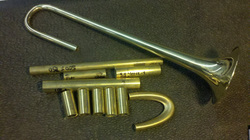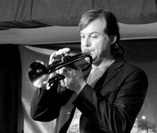|
Finishing the third Gravity trumpet has been a priority the past two weeks. Projects like this require planning from beginning to end and a dash of improvisation or sometimes a full solo chorus with a few unknown chords. The first Gravity design came naturally and I don't recall any complications, but that was two years ago and two years can seem like a lifetime ago when you design something new everyday. Maybe it was difficult and I don't remember? The second design required more hours than I care to admit and this third design was considerably faster, yet still slow considering the numerous design improvements I've made over G2. The brass stock for this trumpet must be special ordered and to my surprise it cost over $400. When the price of gold rises, so do most other metals, I guess.
The Gravity trumpet was designed to offer maximum efficiency while sounding and blending like an ordinary trumpet. This dichotomy poses some very challenging problems. I'll explain... A standard trumpet will blend easily with other trumpets, brass, saxophones and strings. There is a complexity to the overtone series in all of these instruments that allows your ear to confuse them or let's say, it is difficult to differentiate one from another when an entire group plays the sames notes in a chord. For you non-musicians, the surprise is that THIS attribute is preferable. Musicians want to blend together when playing harmonies (backgrounds) and stand out with a unique voice on solo sections. The dreaded fear is that you may stand out when playing the background or worse, maybe even blend in on your solos. Hence, being a musician is more than learning your scales and playing the right notes on the page. We must listen and fit in or stand out whenever necessary. The first and second trumpet players are often wearing both hats, playing harmonies and melodies back and forth throughout a song. Easy so far, right? The real problem is efficiency. Yeah, I can improve efficiency in anything whether it be your kitchen aid blender, a jet airliner or your trumpet. But improving the efficiency of a musical instrument often has the adverse side affect of changing the timbre or sound. Better bearings and tighter tolerances in a blender will reduce noise and increase power and speed. On a 747, reducing drag and vibration improves fuel consumption and I'm guessing reduces noise...does anyone have a jet I can experiment with next weekend? And improving efficiency on a trumpet actually increases dynamic range allowing you to play considerably louder and softer. However, incorporate physics in the wrong places and your vibrant vocal trumpet may soon sound like a synthesizer set on a basic sine wave. High efficiency designs reduce upper overtone complexity, which translates to a dull simple tone. Believe it or not, the reason we love that unique trumpet sound (most of us anyway) is because the instrument's ineffiencies introduce a complex series of overtones or partials into the sound. These are not part of the original design within the mouthpiece, leadpipe and bell. They are artificially added when the brass wall of the instrument is set into motion by vibration, the standing wave. This is where SWE or Standing Wave Efficiency loses its luster and incorporating physics principles becomes more art than science. If SWE were the simple solution to the problem, I would have been done years ago and may be working on 747's today! Great solutions are often simple in principle and quite complex in practice, thus I may never be finished with the trumpet. So why does the Gravity play so very efficient and yet sound like a trumpet? Well, I could tell you, but that really is a secret I'd rather save for a conversation in person. If you really want to know, ask me when you see me and I'd be happy to show you how and why this is possible. The important thing is that the Gravity design DOES balance both Standing Wave Efficiency AND tone. Previous attempts to produce ultra high efficiency trumpets resulted in unbelievably easy playing horns that sounded dull even when compared to a snare drum. All you guys that joke about me building a horn out of a solid chunk of brass where you only see two holes (mouthpiece and bell taper) are partially right. It would in theory be the most efficient, but it would sound very foreign and offer limited applications. This sounds familiar...like a competition or sniper rifle designed for high accuracy long distance applications. Long distance can sometimes be hitting a target more than a mile away with sound dissapation masking the source. This is achieved by combining a skilled sharpshooter with high grade ammunition and a well-designed, very accurately machined, heavy competition rifle. The physics principles incorporated into the Gravity trumpet are found in sniper rifles and cell phone towers. Wow, how are all of these related? They are simply designed to reduce energy loss during transmission of the projectile, radio wave or in our case, the sound wave. The Gravity is more like a cell tower and rifle than you may think. I'll leave you with that and move on to playing the Gravity. Since there are only 3 Gravity trumpets in existence and apparently over 500 people reading this blog, I can safely assume you don't all have the ability to try one of my creations. So I'll give you my personal experience playing this horn and how I approach high efficiency instruments, whether they be trumpets, rifles, blenders or cars. Playing the Gravity is much like driving a winding mountain road with no headlights. Leaving the headlights off makes things easier, and probably safer, in a car. You see, we don't really use our brains anymore. Seriously, we've learned the structure of the world around us, we know the systems, shapes, textures, smells, movements, etc. and our brains predict what will happen and run on automatic pilot. To demonstrate my this, simply get out of bed tomorrow morning without opening your eyes and see if you have much difficulty getting around your house, maybe to the kitchen or bathroom. You could probably get dressed, eat breakfast and get the keys into the ignition before you ever need to see anything. We run on autopilot when we play trumpet as well. How many of us pick up our horn and think about anything? Maybe if you're taking lessons in high school or college you think about some things, but is it a fresh experience for any of us? I challenge you to make it a fresh experience everytime you pick up the horn. Imagine what it can do that you haven't tried. Learn to drive at night with your eyes open and your HEADLIGHTS OFF. Do this and you will discover things you never noticed before. And you'll become a better driver. An added benefit is that deer will not be blinded by your headlights and will actually jump out of the way when they see your car. So here's my disclaimer...do this at your own risk and keep in mind driving with your headlights off at night is illegal everywhere, even though it is safer so long as you are the only vehicle on a safe road. Now that I've done that, let me share a secret...I've been driving with no headlights since I was 18. I used to drive from college in Minnesota to my parents' home in Montana a few times a year. Being intimately familiar with the damage done by collisions with animals at night, I became very aware of activity on the sides of the road before and after sunrise and sunset. I started trying new things to see them earlier and then even to deter them from my path. I invented animal prevention systems in my mind on these trips, some elaborate relying on sonar, infrared or even ultrasonic technology. Yet most of these seemed unrealistic due to cost. So one night I was driving my 1976 Plymouth Scamp painted flat black across North Dakota and forgot to turn my headlights on after my last stop for gas. I drove for maybe twenty minutes before a truck almost ran me over from behind, then passed at the last second and layed on his horn. Oh, my headlights were off and I hadn't even noticed! I turned them on and instantly suffered from significantly reduced visibility. I literally could not see beyond my headlights, which isn't far compared to when my eyes were adjusted to starlight. Then it clicked, drive without them...and that's what I've done ever since. What happened over time was completely unexpected. I started to understand that people were kind of sleeping through life driving with their headlights on. I could see that glazed look in a student's eyes when he was playing in a lesson. How can I wake this kid up? Find a way to force him to listen with new ears. That's the answer, wake up and listen, wake up and think! Some things that have worked for me; earplugs, ambient noise, soft mutes, open a water key AND play the Gravity. Everything you do on this horn is magnified beyond what you know as possible. It's like driving a delivery truck for twenty years, then switching to a Ferrari. Every interval seems ridiculously closer than before...two octaves feels like a fifth, upper register work feels like it's in the staff and playing soft is naturally comfortable and extremely easy...just like driving a Ferrari. So what is it like to play the Gravity trumpet? Like a completely new experience as if you've never played a trumpet a day in your life. It forces you to wake up and think, no more living from memory, you have to take your skill at this very moment and control everything, but when you do, the rewards are great and the feeling is addictive. I challenge you to wake up your brain and approach everything in life as if it were new, even if it isn't. Jason
2 Comments
Dave Wondra
1/26/2011 12:40:34 pm
Jason - I'm glad I happen to stop by the shop one day when Gravity 1 was still around. Playing it was a surreal experience - I can still remember how strange it felt to play a two-octave scale with the effort that would normally go into traveling a distance of three successive notes on a regular trumpet. Effort-wise, it felt more like I was playing some sort of keyboard - I kept a relaxed stream of air going and I didn't have to change it much to move great distances on the horn as I continued to press the valves. Also, it took some real restraint to play softly since there was little energy loss as my vibrations made their way through the Gravity.
Reply
1/27/2011 12:41:00 am
I still remember the first time you turned the headlights off half way to Billings.... I thought I was going to die.
Reply
Your comment will be posted after it is approved.
Leave a Reply. |
Jason Harrelson
Inventor, Musician, Educator and Founder of Harrelson Trumpets, Trumpet Momentum and Harrelson Momentum. Archives
July 2024
|






 RSS Feed
RSS Feed
